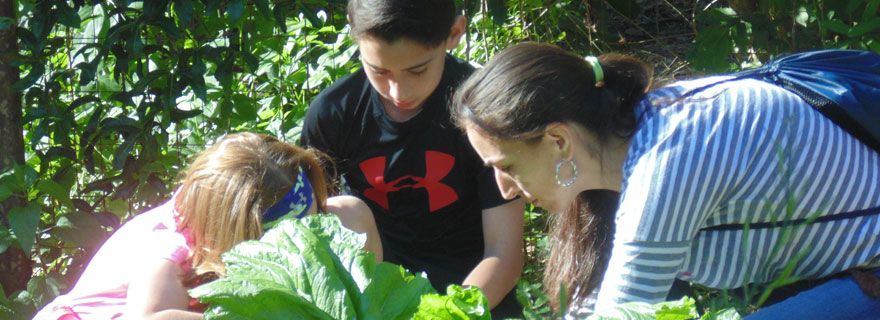Top: Students examine lettuce plants for pests with help from experts at the Learning Gate Bioblitz. Photos by Victoria Parsons
By Helena Rodriguez and Anna Slean
Dozens of students and parents – even more than the most optimistic organizers had expected – turned out for the first-ever Learning Gate Bioblitz on April 9th at the Learning Gate Hanna campus in Lutz.
According to Jim McGinity, the environmental science teacher for the K-6th grade campus (more affectionately known as Mr. Jim), Bioblitzes were started by scientists in the late ‘90s. They were originally meant to gather a “rapid inventory” and “document as many plants and animals on a given property.”
Mr. Jim explained that his reasoning for wanting to put on an event like this was to create an environment where parents and students could interact with environmental scientists and experts. “This gives ordinary people a chance to be educated and get hands-on experience in a new field – we’re creating teams of citizen-scientists because we’ll never have enough scientists to gather this kind of data.”

Teams of parents, teachers and students were assigned to an expert in one of seven categories to document as many species as possible in their species type. Mr. Jim also stated that official Bioblitzes were done in a 24-hour period, though when most volunteers heard that, they laughed. Learning Gate’s first Bioblitz only lasted about four hours. Though in that time, experts worked closely with students and parents to not only inform them about identifying species, but also collecting real live specimens.
Andrew Nisip, a terrestrial scientist who was volunteering from the University of Florida, said he’d driven down from Gainesville because he was “excited to be showing the students and parents things that they wouldn’t normally see on their own, or the common things they might have overlooked.”
Prior to the event, participants had downloaded an app on their device called “Inaturalist.” The app enables you to record your plant and animal findings through your phone. This assists the different teams in documenting their findings when they couldn’t bring back physical specimens, such as the bird group. It also allowed scientists to identify or confirm sightings, particularly of unusual species.
The capability and knowledge that the college volunteers brought with them and exposed to the kids was phenomenal. Taegan McMahon, an associate professor and amphibian specialist from the University of Tampa, talked about a frog that one of the kids had caught. She explained that even though they were keeping most of the amphibians they caught in plastic bags, it wasn’t hurting them. “Because of their sensitive skin, the plastic is actually better for them,” she said while taking the frog out of the Ziploc baggie. McMahon added that frogs don’t use as much oxygen, so they’re not breathing up a lot of the oxygen in the bag.
Though this may have been the first “Bioblitz,” it wasn’t the first time an event like this occurred on the Learning Gate Community School campus. Before the school’s development, a group of volunteers and people who were environmentally capable went out onto the school campus and looked at plants to see what kind of biodiversity there was on the campus. Another reason they were there was to determine what trees they should chop down and what trees they should keep. One of those volunteers happened to be Carmel VanHoek, who was participating in the Bioblitz on April 9.
In the four hours spent wandering about the campus, everyone was able to bring back some kind of evidence of reptiles and amphibians, terrestrial and aquatic insects, spiders, birds, or terrestrial or aquatic plants. Even so, most participants thought that what was most important was the interaction between the college volunteers and students. Gabe Somrriba, another UF specialist, said that he was excited to educate people about insects and expose them to things that might scare or gross people out.
The very first Bioblitz at Learning Gate Community School has been a success and Mr. Jim is already planning another event for 2017 with even more scientists and community members. As Ms. Jamie Morgan, a fifth-grade teacher at Learning Gate Community School said during her interview, “Learning Gate Community School is a great place to do an event like this, it’s like a jewel in the midst of all this construction around it.”
Helena Rodriguez (8th grade) and Anna Slean (6th grade) are aspiring journalists at Learning Gate Community School.
